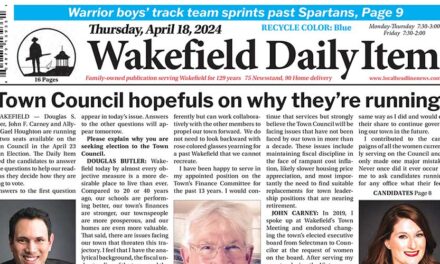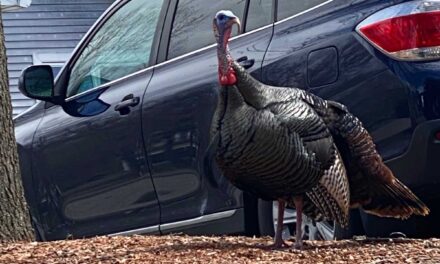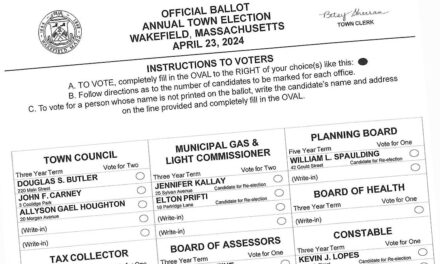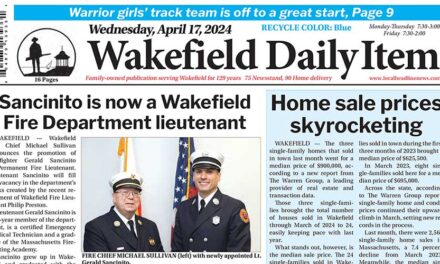Published in the April 14, 2017 edition.
By GAIL LOWE
WAKEFIELD — Imagine being out for a night on the town at a nightclub known for its grandeur, glitz and glamour. Maybe you’re on a first date or celebrating a special occasion. Or perhaps your name is Buck Jones, and you’re a famous cowboy star out with your friends for a night of fun. You’re laughing and enjoying the company of your loved ones and best buddies. Then, all of a sudden, you smell it. Then you feel it. You scream “Fire!”
This happened so quickly on the night of Nov. 28, 1942 that there may not have been enough time for revelers and staff to grasp the reality of the deadly fire that raged through the Cocoanut Grove Nightclub in Boston’s South End. In the short span of 12 minutes, 492 people were dead, including Buck Jones. Countless others were injured.
Boston area resident and freelance writer Stephanie Schorow said that the majority of victims of the Cocoanut Grove fire died of suffocation and carbon monoxide poisoning. A smaller number died as a direct result of severe burns.
Schorow is an expert on the Cocoanut Grove fire, as well as other notable fires in Boston, and spoke about them on Wednesday night, April 12 at the second of the three 2017 Sweetser Lectures held at The Savings Bank Theatre inside Wakefield Memorial High School.
During her lecture, Schorow focused on three devastating fires in the Boston area: The Ursuline Convent in Charlestown in August 1834 that was started by anti-Irish Catholic mobsters; downtown Boston’s great fire that leveled 700 buildings over 60 acres, leaving thousands of people jobless and homeless, and perhaps the most famous of all, the Cocoanut Grove fire. She has written and lectured extensively about these fires, including one book titled “The Cocoanut Grove Fire” (soft cover 75 pages).
During her hour-long talk, Schorow said she first became interested in fires when she was a cub reporter working at a small newspaper in the Midwest. After moving to Boston in 1989, she worked for the Associated Press and as an editor and reporter for the Boston Herald. She is now a freelance writer, author of seven books on Boston history and teacher of journalism and professional writing at several Greater Boston colleges.
“We all need to be concerned about fire,” she said during her opening remarks.
To this day, she said, people talk about the Cocoanut Grove fire, and they all have stories to tell. One elderly man told Schorow he had planned to be at the nightclub the night of the fire but couldn’t get in. Another person told her he had been at the nightclub but left before the fire started. Yet another said she decided at the last minute not to go. Any one of these people could have been victims, Schorow said.
She gave a brief history lesson concerning the Cocoanut Grove. It was built in the 1920s in the Bay Village at 17 Piedmont St. a few blocks south of Boston Public Garden. The nightclub got its name from a swank club in Los Angeles. The first owners — Mickey Alpert and Jacques Renard — spared no expense in décor. With a tropical paradise theme, there were artificial palm trees, coconut husk sconces, heavy draperies and a ceiling draped in blue satin that could be rolled back in summer for dancing under the stars. Since the era of Prohibition prevented alcohol consumption, Alpert and Renard decided to sell the nightclub to Charles “King” Solomon, a gangster who was later mowed down in a spray of bullets. The nightclub then fell into the hands of Solomon’s lawyer Barnet Welansky, who often bragged about his connection to the Mafia.
“Barnie” Welansky, as he was known, was concerned about customers who might leave without paying, so he locked exits, concealed others with draperies and bolted up one emergency exit. Schorow also said he hired an unlicensed electrician even after being warned that he needed permits for the work to be done. He paid no heed to the warning.
According to Schorow’s research, on the night of the fire, a young couple sat in the Melody Lounge located on the lower level of the nightclub. Witnesses said that the man, a soldier, wanted privacy with his date, so he unscrewed a light bulb next to their table so they could kiss in the dark. The bartender noticed the man’s action, and told busboy Stanley Tomaszewski to screw the light bulb back in. The busboy then climbed onto a bar stool and lit a match so he could see what he was doing. The time was 10:15 p.m. Eight minutes later, a vicious ball of fire rolled through the dining area and cocktail lounge, sucking up all the oxygen.
In a panic, customers and staff ran toward the revolving door at the front of the building, but many could not get out because of the pile-up of people.
“Many tried to get their coats (before leaving), which in those days were considered major investments,” said Schorow.
Marshall Cole, a teenager who worked as a chorus boy, managed to get out, Schorow said, but not before losing his pride and joy — his camel hair coat.
Other people rushed back inside the nightclub to find loved ones. Many perished by doing so.
One of Schorow’s slides showed a picture of nurses at Boston City Hospital taking care of victims of the fire. Some good came out of the tragedy — pioneering medical treatments with fluids, petroleum jelly, gauze and antibiotics. Studies were also done on grief as it pertains to survivors of a tragedy.
New fire and safety regulations were also put in place, including a regulation concerning revolving doors. All revolving doors now must have a door to their right and left.
“Regulations and safety precautions may seem onerous or unnecessary until disaster strikes,” said Schorow. “Then you’ll be grateful for sprinkler systems or safety lights or exits that are not kept locked. Sure, codes add to the cost of projects, but the majority of the deaths in the Cocoanut Grove fire could be attributed to the conditions of the club, including overcrowding, locked exits, little access, as much as to the flames and smoke.” (The club had a capacity for 500 people, but it is estimated that 1,000 people were inside the club on the night of the fire.)
The cause of the Cocoanut Grove Fire may never be known. Some think it spread quickly because of some kind of mystery gas, maybe a substitute for Freon, which was scarce due to military needs during World War II. Others blamed Tomaszewski, the young busboy who held a lit match near flammable material. He would go to his grave with the knowledge that many held him accountable.
As for Welansky, he served nearly four years in prison after being convicted on 19 counts of manslaughter.
To memorialize the people who lost their lives in Boston’s most famous fire, Schorow said that a short street running through the former site of the nightclub called Shawmut Extension was renamed Cocoanut Grove Lane during a ceremony held Nov. 30, 2013. Several survivors of the fire attended the event along with invited guests.
Schorow is on the board of the Boston Fire Historical Society, an organization devoted to preserving Boston’s fire history. For more information related to the Cocoanut Grove and other fires, visit the National Fire Protection Association at www.nfpa.org.
Schorow is currently working on a history of Boston’s notorious Combat Zone from the 1960s to the 1990s. The book is due out late this summer.
The final lecture of the 2017 season will be held on Wednesday, May 3 at 7:30 p.m. when author, historian and lecturer Stephen Puleo will be guest speaker. Tickets are now available at Smith’s Drug Store, 390 Main St. or by mail addressed to Sweetser Lecture Series, P.O. Box 1734, Wakefield, MA 01880 (include a self-addressed stamped envelope). Single ticket $10. Tickets will also be sold at the door.
Net proceeds from the 2016 series benefited the Mystic Valley Elder Services (Wakefield residents only), the Wakefield branch of the Salvation Army Holiday Kettle Fund and the Wakefield Interfaith Food Pantry.
The Sweetser Lecture Series was established in 1885 by a bequest from Cornelius Sweetser instructing that the proceeds from the lectures be donated to worthy charitable organizations in Wakefield.




